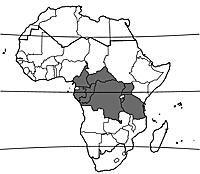Baphiopsis parviflora (PROTA)
Introduction |
| General importance | |
| Geographic coverage Africa | |
| Geographic coverage World | |
| Medicinal | |
| Timber | |
| Fuel | |
| Ornamental | |
| Climate change | |
Baphiopsis parviflora Baker
- Protologue: Oliv., Fl. trop. Afr. 2: 256 (1871).
- Family: Caesalpiniaceae (Leguminosae - Caesalpinioideae)
Synonyms
- Baphiopsis stuhlmannii Taub. (1895).
Origin and geographic distribution
Baphiopsis parviflora occurs from Cameroon and Gabon, through the Central African Republic and DR Congo, east to Uganda and north-western Tanzania.
Uses
In Uganda the wood is used for handles of implements and tools such as hoes, axes and saws.
Properties
The non-protein amino acid trihydroxypipecolic acid has been isolated from the leaves; this compound was only known from the genus Baphia.
Description
- Shrub or small tree up to 15 m tall, often leaning or sprawling; bark smooth, reddish brown; twigs short-hairy to glabrous.
- Leaves arranged spirally, simple and entire; stipules very small and soon falling off; petiole 0.5–4 cm long, thickened at both ends; blade usually elliptical, (3–)4–20(–25) cm × 1.5–11 cm, obtuse to rounded at base, acuminate at apex, leathery, glabrous, pinnately veined with 5–8 pairs of lateral veins.
- Inflorescence an axillary raceme or fascicle up to 3.5 cm long, short-hairy.
- Flowers bisexual, regular; pedicel 0.5–2 cm long; calyx ellipsoid and entire, opening by a single slit or becoming 2–3-lobed, with 2 small caducous bracteoles at base; petals 6, free, nearly equal, elliptical to obovate, 0.5–1 cm long, white; stamens 13–18(–40), free; ovary superior, sessile, hairy to glabrous, 1-celled, style slender, slightly curved.
- Fruit an oblong pod 3–4(–6) cm long, with short beak, reticulately veined, black, 1(–2)-seeded.
- Seed oblong, 2.5–4 cm long, thin-walled.
Other botanical information
The fruits are eaten by monkeys such as guenons, mangabeys and colobus monkeys, which may serve as seed dispersers.
Baphiopsis comprises a single species. Its affinity is still uncertain, but in recent classifications it is usually placed in the tribes Swartzieae or Sophoreae of the family Papilionaceae (Leguminosae - Papilionoideae), and it may be related to Baphia. Its flowers, with their 6 nearly equal petals and more than 10 free stamens, do not have the characteristic papilionaceous structure, and therefore Baphiopsis was until recently usually classified within Caesalpiniaceae.
Ecology
Baphiopsis parviflora occurs in the understorey of lowland rainforest or riverine forest up to 1300 m altitude. It usually occurs scattered in the forest, but is locally abundant as in western Uganda.
Genetic resources
There are no indications that Baphiopsis parviflora is threatened. It is widespread and is not particularly sought after.
Prospects
The tree is too small and poorly shaped to be of any future importance for its timber.
Major references
- Brenan, J.P.M., 1967. Leguminosae, subfamily Caesalpinioideae. In: Milne-Redhead, E. & Polhill, R.M. (Editors). Flora of Tropical East Africa. Crown Agents for Oversea Governments and Administrations, London, United Kingdom. 230 pp.
- Burkill, H.M., 1995. The useful plants of West Tropical Africa. 2nd Edition. Volume 3, Families J–L. Royal Botanic Gardens, Kew, Richmond, United Kingdom. 857 pp.
Other references
- Aubréville, A., 1968. Légumineuses - Caesalpinioidées (Leguminosae - Caesalpinioideae). Flore du Gabon. Volume 15. Muséum National d’Histoire Naturelle, Paris, France. 362 pp.
- Aubréville, A., 1970. Légumineuses - Césalpinioidées (Leguminosae - Caesalpinioideae). Flore du Cameroun. Volume 9. Muséum National d’Histoire Naturelle, Paris, France. 339 pp.
- Eggeling, W.J. & Dale, I.R., 1951. The indigenous trees of the Uganda Protectorate. Government Printer, Entebbe, Uganda. 491 pp.
- Kite, G.C., 2003. Taxonomic significance of the trihydroxypipecolic acid ‘BR1’ in Baphiopsis parviflora (Leguminosae). Biochemical Systematics and Ecology 31(1): 45–50.
- Lewis, G., Schrire, B., MacKinder, B. & Lock, M., 2005. Legumes of the world. Royal Botanic Gardens, Kew, Richmond, United Kingdom. 577 pp.
- Wilczek, R., Léonard, J., Hauman, L., Hoyle, A.C., Steyaert, R., Gilbert, G. & Boutique, R., 1952. Caesalpiniaceae. In: Robyns, W., Staner, P., Demaret, F., Germain, R., Gilbert, G., Hauman, L., Homès, M., Jurion, F., Lebrun, J., Vanden Abeele, M. & Boutique, R. (Editors). Flore du Congo belge et du Ruanda-Urundi. Spermatophytes. Volume 3. Institut National pour l’Étude Agronomique du Congo belge, Brussels, Belgium. pp. 234–554.
Author(s)
- R.H.M.J. Lemmens, PROTA Network Office Europe, Wageningen University, P.O. Box 341, 6700 AH Wageningen, Netherlands
Correct citation of this article
Lemmens, R.H.M.J., 2010. Baphiopsis parviflora Benth. ex Baker. [Internet] Record from PROTA4U. Lemmens, R.H.M.J., Louppe, D. & Oteng-Amoako, A.A. (Editors). PROTA (Plant Resources of Tropical Africa / Ressources végétales de l’Afrique tropicale), Wageningen, Netherlands. <http://www.prota4u.org/search.asp>.
Accessed 6 March 2025.
- See the Prota4U database.

